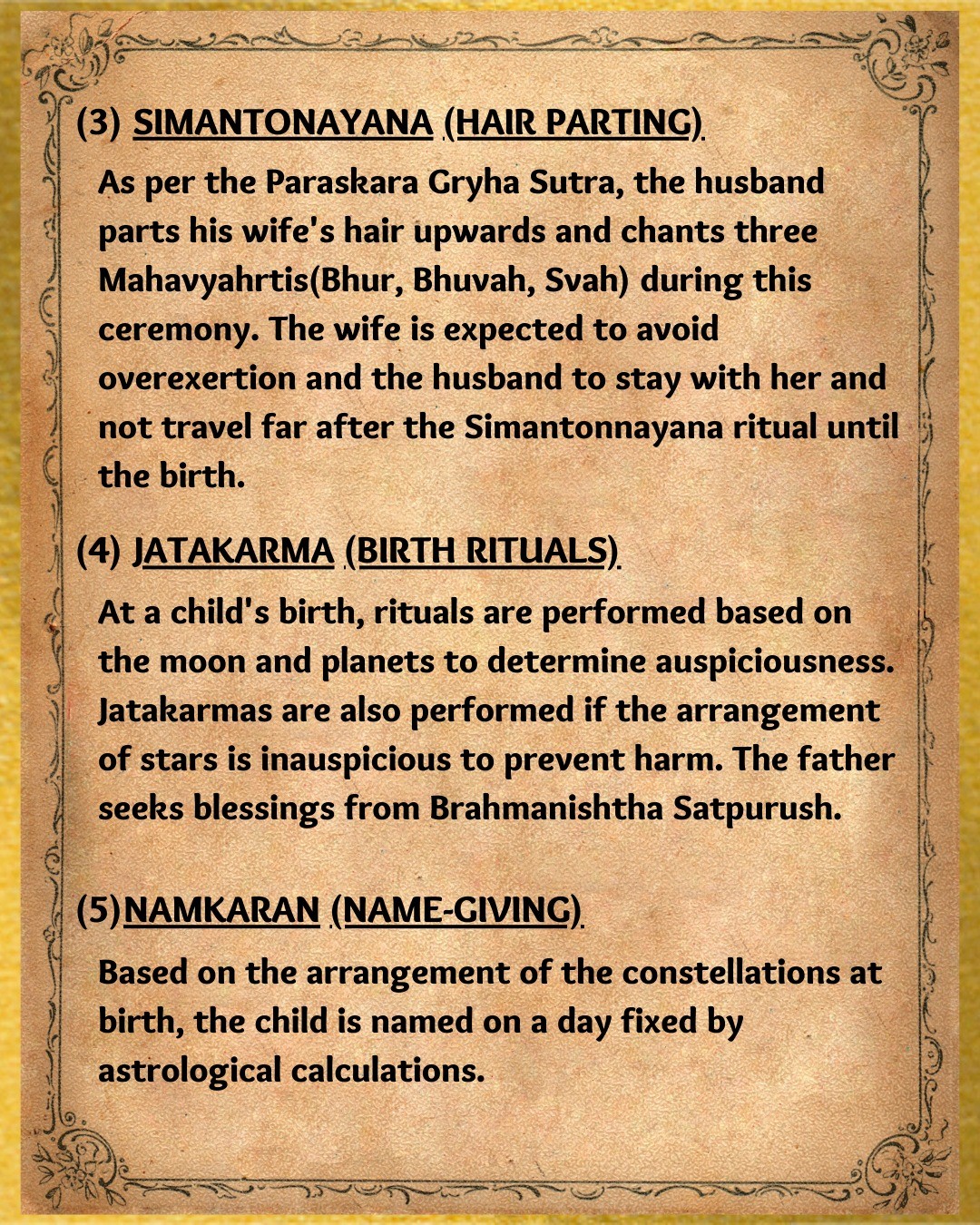WHAT ARE THE 16 SANSKARS IN HINDUISM? EVERY HINDU MUST KNOW THIS.
(1) GARBHADAN (CONCEPTION).
"Do not terminate one's lineage - let it continue (by having children)."
(2) PUMSAVANA (FOETUS PROTECTION AND ENGENDERING MALE OR FEMALE).
Pumsavana is a rite of passage observed when the pregnancy begins to show, typically in or after the third month of pregnancy and usually before the fetus starts moving in the womb. The ceremony celebrates the rite of passage of the developing fetus, marking the stage where the baby begins to kick as a milestone in a baby's development.
(3) SIMANTONAYANA (HAIR PARTING).
As per the Paraskara Gryha Sutra, the husband parts his wife's hair upwards and chants three Mahavyahrtis(Bhur, Bhuvah, Svah) during this ceremony. The wife is expected to avoid overexertion and the husband to stay with her and not travel far after the Simantonnayana ritual until the birth.
(4) JATAKARMA (BIRTH RITUALS).
(5) NAMKARAN (NAME-GIVING).
Based on the arrangement of the constellations at birth, the child is named on a day fixed by astrological calculations.
(6) NISHKRAMA (FIRST OUTING).
In the third month the child is allowed agni (fire) and chandra (moon) darshan. In the fourth month he/she is taken out of the house for the first time, by the father or maternal uncle, to a Temple.
(7) ANNAPRASHAN (FIRST FEEDING).
Feeding the child with solid food is the next important samskara. For a son this is done in even months - the 6th, 8th, 10th or 12th months. Odd months for daughter - 5th, 7th or 9th. Mothers should stop breastfeeding the child after this rite.
(8) CHUDAKARMA (SHAVING OF HEAD).
This samskara involves shaving the head (of a son) in the 1st, 2nd, 3rd or 5th year, or when initiating him with the janoi (Upanayan).
(9) KARNAVEDH (PIERCING THE EARLOBES).
The child's ear lobes are pierced on 12th /16th day; 6th/7th/8th month; 1st/ 3rd / 5th / 7th or 9th year.
(10) VIDYARAMBH (LEARNING THE ALPHABET).
This samskara is performed at the age of five and is necessary before commencing Vedic study After bathing, the child sits facing west, while the acharya (teacher) sits facing east. With a gold or silver pen the child is made to write letters on the rice. The following phrases are written: "Salutation to Ganesh, salutation to Sarasvati salutation to family deities and salutation to Narayan and Lakshmi." The child then writes, "Aum Namah Siddham". He then presents offerings to the acharya. The acharya then blesses the child.
(11) UPANAYAN (SACRED THREAD INITIATION).
At the age of eight the son is initiated by the acharya with the sacred thread, known as janoi, janeu or yagnopavit. Amongst all the foregoing samskaras this is regarded as supreme. It is the dawn of a new life, hence dvija - twice born. The child enters studentship and a life of perfect discipline which involves brahmacharya (celibacy).
(12) VEDARAMBH (BEGINNING VEDIC STUDY).
This samskara was not mentioned in the earliest lists of the Dharma Sutras. It seemed that though upanayan marked the beginning of education, it did not coincide with Vedic study. In this samskara, each student, according to his lineage, masters his own branch of the Vedas.
(13) KESHANT (SHAVING THE BEARD).
This samskara involves the first shaving of the beard by the student at the age of sixteen. It is also called Godaan because it involves gifting a cow to the acharya and gifts to the barber.
(14) SAMAVARTAN (END OF STUDENTSHIP).
This samskara is performed at the end of studentship. 'Sama vartan' meant 'returning home from the house of the acharya.' This involves a ritual bath known as Awabhruth Snan. It marks the end of the long observance of brahmacharya.
(15) VIVAHA (MARRIAGE).
This is the most important of all the Hindu Samskaras. The Smrutis laud the gruhastha (householder) ashram as the highest, for it is the central support of the other three ashrams. By marriage an individual is able to achieve the four purusharths (endeavors) of life: dharma (righteousness), artha (wealth), kama (desire) and moksha (salvation). He is also able to play off ancestral debt by having children.
(16) ANTYESTHI (DEATH RITES).
Antyeshti is the final samskara in a Hindu's life. Though performed after the death of a person by his relatives, it is of importance because the value of the next world is higher than that of the present.






